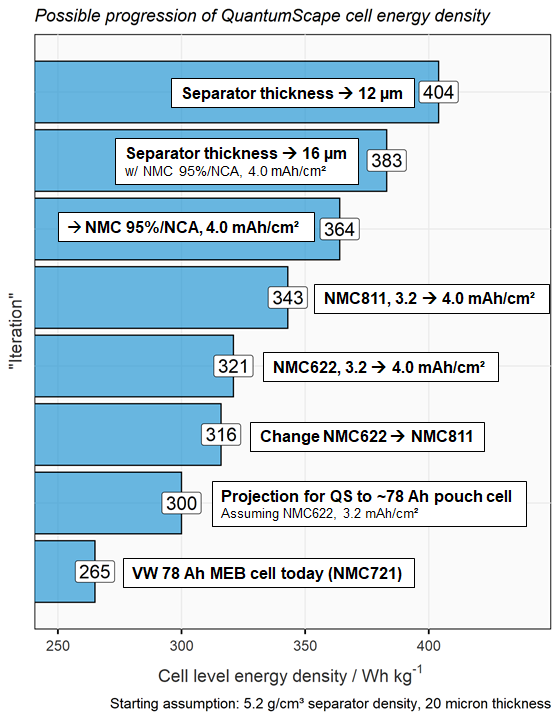Pathways for QuantumScape to improve energy density
One more(!) short thread on QuantumScape on energy density, since some were interested: based on new info last week, w/ direct scale up of where QS seems to be now gets ~300 Wh/kg, with getting to 400 Wh/kg dependent on increasing mAh/cm² and thinning the separator.

I’ve had to make some assumptions here obviously - mostly that QS can already make 20 μm separators (ARPA-E target), currently use NMC622, have a catholyte based on sulfolane (hinted in patents) and no performance loss from scale up…
I’m also assuming they have or are utterly sure they can hit this ARPA-E target, esp considering Paul Albertus, director of the ARPA-E IONICS program, was in last week’s panel, and QS + scientific advisors must know this is absolutely crucial for success.
With other ‘typical’ materials, and using other info they revealed, this is what I calculate (take with pinch of salt!) for 30x10 cm pouch cell with 41 stacked layers which in the first scenario gets the same 78 Ah as VW’s existing MEB cell (sensible target, I think).
Going to NMC811 and 4 mAh/cm² shouldn’t be an issue and more Ni rich cathodes with higher capacity seem on the way (Tesla already use something with this performance). On that basis 365 Wh/kg is well in reach if they are successful in scaling up.
Separator mass is ~25% of cell at this point, Volumetric energy could break above 1000 Wh/L however. Incidentally, following my recent catholyte thread, my model gives me ~65-70% less liquid electrolyte compared to typical Li-ion.
To reach 400 Wh/kg from here, the separator probably needs to be thinner. 12 μm is about what typical polymer separators are now. No comment on how easy/hard this will be…
I estimated ~350 Wh/kg back in September and I still end up around the same now, though maybe the route to 400 Wh/kg looks a little less difficult now. All of it depends on that mysterious separator though. Probably I’ll come back to this as QS reveal more over time…